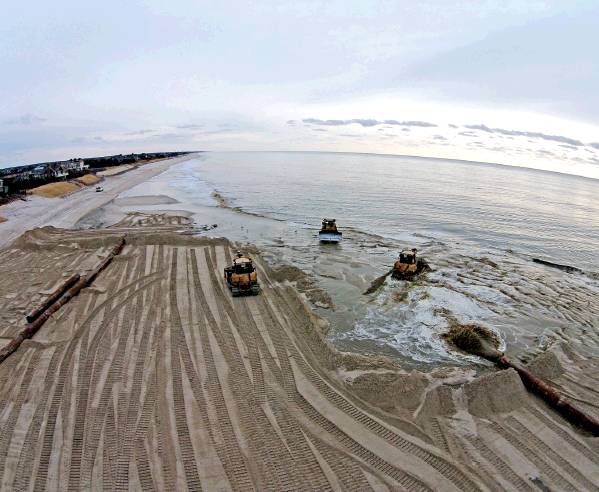Beach Work Is Slated To Continue Into 2014
BY MICHAEL WRIGHTThe massive beach reconstruction project under way in eastern Southampton Town is about two-thirds completed, though project engineers now say they expect the work to continue into the new year.
So far, the dredging barge Illinois has pumped some 1.6 million cubic yards of sand ashore, onto a stretch of beach running from Flying Point Beach in Water Mill to just east of Sagg Main Beach in Sagaponack Village, a distance of about four miles. About two miles remains, extending the beach widening all the way to the East Hampton Town line. Workers are now working on Sagg Main Beach.
An additional 900,000 cubic yards of sand will be needed to complete the job, as designed in the project outline. When all is going well, the crews have been pumping about 70,000 cubic yards, more than 100,000 tons, of sand per day onto the beach and into the surf. Work on the $26 million beach nourishment project began in late October and was originally supposed to wrap up before the end of the year.
All has not gone well throughout the process, however. The project has been delayed on several occasions, some of them extended, due to bad weather and ill-timed equipment malfunctions. The original contract with the town required that the work be completed by December 31, a deadline that project engineer Dr. Tim Kana now says is not going to be met.
The contracts with the town allow for financial penalties to be imposed on the dredging company and project designers for not meeting the deadline; the amount of those potential fines was not immediately clear. But the contract also provides allowances of extra time based on delays caused by severe weather, so penalties could be unlikely. The project permits are valid until March 2014.
“The latest schedule is a wrapup around the first week of January, allowing for some additional weather delays in there,” said Dr. Kana, owner of Coastal Science & Engineering, the North Carolina firm that designed the beach nourishment project. “It will be somewhat at the discretion of the town whether to impose any penalties, though that is something that is rarely invoked in a case like this, when we’ve had so many weather events.”
Along with strong winds and storm-tossed seas that have kept the Illinois from scouring sand off the sea floor on several occasions, the equipment on the dredge has broken at least twice, inconveniently coinciding with days of calm weather when work could have progressed. Such mechanical failures are the nature of such abrasive work that involves blasting sand with high-pressure pumps, said project manager Jared LeFranc of the Great Lakes Dredge & Dock Company, the firm that operates the Illinois.
After one of last month’s delays, there had been discussion among project managers that a second dredge could be brought in. Most recently, the work was paused early Monday morning as a storm front swept through the area; work resumed again at around 8 a.m. Tuesday.
The sand is now being taken from the second of three socalled “borrow areas,” the sections of ocean bottom about a mile offshore where the Illinois is sucking up the sand. The pipe is coming ashore just east of Sagg Main Beach, which is now the staging area for the project equipment.
In the areas where the work has been completed, the areas of dry beach have more than doubled in width. The project designers say the full width seen now will probably not be maintained for more than a few months; waves will eat away some of the new sand, adding to the sloping profile below the surface of the water that will help dampen the erosive effects of waves in future storms. Also, blowing winds will push some of the sand landward, raising the height of the beach and helping to rebuild some of the natural dunes.
The pumping crews will work straight through the holiday season, including on Christmas Day, if weather allows, Dr. Kana said.
“They’re pumping very efficiently when they are working,” Dr. Kana said of the crews with the Great Lakes Dredge & Dock Company. “It’s actually been a very smooth job.”
